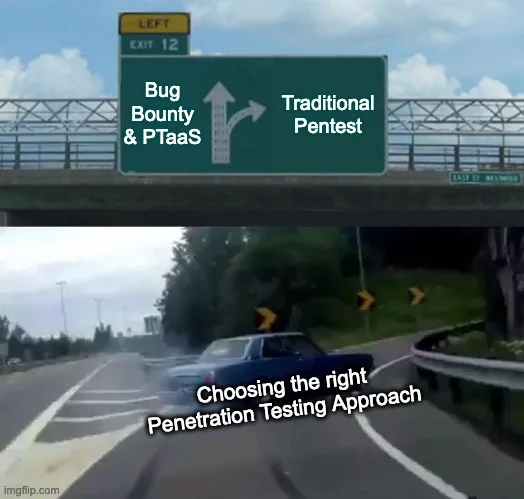Traditional Penetration Testing
Traditional penetration testing involves a dedicated team conducting a thorough assessment within a set timeframe. This method provides a detailed snapshot of an organization’s security posture, offering comprehensive insights and actionable recommendations. Its in-depth analysis and personalized approach make it a valuable choice for organizations prioritizing thorough security evaluations. Pentesters have the flexibility to employ innovative strategies, think outside the box, and creatively simulate real-world attack scenarios to uncover vulnerabilities effectively. Additionally, traditional penetration testing allows for holistic testing of internal systems and services, as well as components requiring special attention or a unique setup.
Pros
- In-Depth Analysis: Detailed examination of vulnerabilities and risks.
- Clear Scope: Focused testing on specific areas of concern.
- Comprehensive Reporting: Detailed reports with actionable insights and recommendations.
- Holistic Testing: Ability to assess internal systems and services comprehensively, including components requiring special attention or a unique setup.
- Well-Crafted Scenarios: Pentesters develop realistic attack scenarios tailored to the target scope, often collaborating with developers or administrators to refine them based on previous knowledge, enhancing testing effectiveness.
Cons
- Snapshot Approach: Testing is limited to a point-in-time assessment, potentially missing emerging threats.
- Time-Intensive: Traditional penetration testing processes can be time-consuming, requiring significant coordination and scheduling between the testing team and the organization's staff.
- Potentially High Initial Investment: Traditional penetration tests sometimes require significant upfront costs, including hiring specialized cybersecurity professionals, setting up testing environments if needed, and project management.
Bug Bounty Programs
The establishment of bug bounty programs marked a significant shift in cybersecurity testing, harnessing the collective expertise of ethical hackers worldwide. These programs offer rewards for identifying vulnerabilities. While bug bounty programs leverage diverse talent and scalability, they may lack the comprehensive analysis provided by traditional testing. Bug bounty programs may not adequately address internal systems and services, limiting their scope.
Pros
- Diverse Expertise: Access to a wide range of skills and approaches.
- Scalability: Large communities can tackle many types of attacks.
- Cost-Effective: Pay-per-result model can align expenses with outcomes.
Cons
- Quality Assurance: Ensuring reliable results amidst varying skill levels.
- Emphasis on Low-Hanging Fruit: Bug hunters may prioritize easily discoverable vulnerabilities for quick returns, potentially overlooking complex issues.
- Confidentiality Concerns: Sharing sensitive information may raise confidentiality concerns.
- Scope Limitation: Bug bounty programs may not adequately address internal systems and services.
Penetration Testing as a Service (PTaaS)
PTaaS represents the latest evolution in penetration testing, offering a subscription-based model for ongoing security assessments. Organizations receive continuous monitoring and testing from cybersecurity experts. However, due to the emphasis on automated testing, PTaaS may not always provide the same depth of analysis as traditional penetration tests, potentially overlooking nuanced vulnerabilities that require manual investigation. While PTaaS promises adaptability and almost real-time issue detection, organizations should consider factors such as recurring costs and dependence on the provider’s capabilities. Conducting vulnerability scans, which are a key component of most PTaaS offerings, can be much cheaper when done quarterly, for example. Alternatively to PTaaS, OSM-S offers comprehensive vulnerability scans conducted by our specialists, who meticulously review the findings and filter out false positives before providing actionable insights to strengthen your security posture at a reasonable price.
Pros
- Continuous Testing: Regular testing to address evolving threats.
- Scalability: Ability to scale testing efforts according to organizational needs.
- Reduced Involvement: PTaaS typically requires less hands-on involvement from the organization's staff due to automated testing processes, allowing them to focus on other critical tasks.
Cons
- Cost: Subscription fees can accumulate over time.
- Vendor Dependence: Relying on the features and capabilities of the PTaaS provider.
- Limited Control: Less hands-on involvement compared to traditional testing.
- Scope Limitation: Components requiring specialized setups may not be continuously testable through PTaaS.
- Emphasis on Automation: Potential lack of depth compared to traditional penetration tests due to automated testing approaches.
Conclusion
Despite the emergence of new approaches like bug bounty programs and PTaaS, traditional penetration testing remains the gold standard for comprehensive security assessments. As organizations navigate the evolving landscape of cybersecurity, traditional penetration testing stands firm as the most reliable choice for safeguarding against emerging threats. Furthermore, traditional penetration testing offers clear scope, comprehensive reporting, holistic testing, and well-crafted scenarios, making it an indispensable option for organizations prioritizing thorough security evaluations. Its detailed analysis and personalized approach provide organizations with invaluable insights into their security posture. OSM-S offers a range of cybersecurity services, including traditional penetration tests and comprehensive vulnerability scans, providing organizations with the tools they need to enhance their security posture and protect against potential threats.

